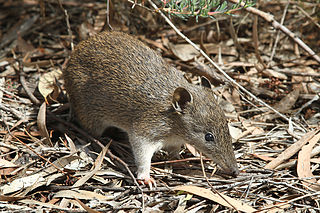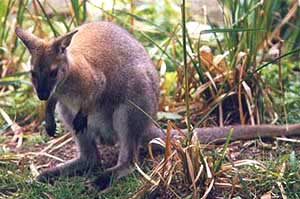Related Research Articles

The order Peramelemorphia includes the bandicoots and bilbies. All members of the order are endemic to Australia-New Guinea and most have the characteristic bandicoot shape: a plump, arch-backed body with a long, delicately tapering snout, very large upright ears, relatively long, thin legs, and a thin tail. Their size varies from about 140 grams up to 4 kilograms, but most species are about one kilogram.

Bandicoots are a group of more than 20 species of small to medium-sized, terrestrial, largely nocturnal marsupial omnivores in the order Peramelemorphia. They are endemic to the Australia–New Guinea region, including the Bismarck Archipelago to the east and Seram and Halmahera to the west.

The New Guinean long-nosed bandicoots are members of the order Peramelemorphia. They are small to medium-sized marsupial omnivores native to New Guinea.

Perameles is a genus of marsupials of the order Peramelemorphia. They are referred to as long-nosed bandicoots or barred bandicoots.

The short-nosed bandicoots are members of the order Peramelemorphia. These marsupials can be found across Australia, although their distribution can be patchy. Genetic evidence suggests that short-nosed bandicoots diverged from the related long-nosed species around eight million years ago, during the Miocene epoch, and underwent a rapid diversification around three million years ago, during the late Pliocene.

The marsupial family Peramelidae contains the extant bandicoots. They are found throughout Australia and New Guinea, with at least some species living in every available habitat, from rainforest to desert. Four fossil peramelids are described. One known extinct species of bandicoot, the pig-footed bandicoot, was so different from the other species, it was recently moved into its own family.

Thylacoleonidae is a family of extinct carnivorous diprotodontian marsupials from Australia, referred to as marsupial lions. The best known is Thylacoleo carnifex, also called the marsupial lion. The clade ranged from the Late Oligocene to the Late Pleistocene, with some species the size of a possum, while members of Thylacoleo reached sizes comparable to living big cats.
Yarala is a genus of fossil mammals that resemble contemporary bandicoots. The superfamily Yaraloidea and family Yaralidae were created following the discovery of the type species Yarala burchfieldi in 1995, on the basis that it lacks synapomorphies that unite all other peramelemorphian taxa.

The Macropodiformes, also known as macropods, are one of the three suborders of the large marsupial order Diprotodontia. They may in fact be nested within one of the suborders, Phalangeriformes. Kangaroos, wallabies and allies, bettongs, potoroos and rat kangaroos are all members of this suborder.
Litokoala is an extinct genus of marsupials, and along with Nimiokoala, is closely related to the modern koala. The three genera may have diverged at an earlier date, although the drying of the continent and the expansion of Eucalyptus forests towards the late Miocene may have delayed the evolution of cranial features unique to the modern genera. This indicates that either fossil genus could be an ancestor of the modern genus, or the modern genus has a common ancestor to both. More material needs collection to improve their taxonomical relationships.
Ganguroo is a genus of fossil macropods found at Riversleigh in Australia, material dating from the Middle to Late Miocene Epoch. The type species of the genus is Ganguroo bilamina, published in 1997. Two recently described species, Ganguroo bites and Ganguroo robustiter, have also been placed in this genus.
Galadi is an extinct genus of predatory bandicoot from Oligo-Miocene deposits of Riversleigh, northwestern Queensland, Australia. It was first named by K.J. Travouillon, Y. Gurovich, R.M.D. Beck and J. Muirhead in 2010 and the type species is Galadi speciosus; additional three species, G. adversus, G. amplus and G. grandis, were described in 2013. The genus is represented by three well-preserved skulls and several isolated maxillae and dentaries. Its body mass would have been close to two pounds, making it relatively large for its family. The combination of body size, robustness and short, stout skull indicates that Galadi would have been able to take relatively large prey for its size, though the morphology of its molars indicates it may have been omnivorous.
This paleomammalogy list records new fossil mammal taxa that were described during the year 2013, as well as notes other significant paleomammalogy discoveries and events which occurred during that year.
This paleomammalogy list records new fossil mammal taxa that were described during the year 2010, as well as notes other significant paleomammalogy discoveries and events which occurred during that year.
Cookeroo is a genus of extinct kangaroos from the Late Oligocene and Early Miocene found in fossil deposits from the Riversleigh World Heritage Area, in Australia. The genus includes two species, C. bulwidarri and C. hortusensis.
This paleomammalogy list records new fossil mammal taxa that were described during the year 2016, as well as notes other significant paleomammalogy discoveries and events which occurred during that year.

Crash bandicoot is an extinct bandicoot, known from fossils located at the Riversleigh World Heritage Area in northeast Australia.
Liyamayi dayi is a mammal species of the Thylacomyidae family known from fossils located at the Riversleigh World Heritage Area in northeast Australia. The discovery of the specimens was identified as deposited around fifteen million years ago, revising the earliest record of this peramelemorphian lineage from those of species that existed around ten million years later.
Lekaneleo roskellyae is a fossil species of carnivorous marsupial that existed during the early Miocene in Australia. Once allied to the type species of the genus Priscileo, later placed as Wakaleo pitikantensis, "Priscileo" roskellyae was subsequently transferred to its own genus Lekaneleo.
This paleomammalogy list records new fossil mammal taxa that were described during the year 2015, as well as notes other significant paleomammalogy discoveries and events which occurred during that year.
References
- ↑ Gurovich, Yamila; Travouillon, Kenny J.; Beck, Robin M. D.; Muirhead, Jeanette; Archer, Michael (2013). "Biogeographical implications of a new mouse-sized fossil bandicoot (Marsupialia: Peramelemorphia) occupying a dasyurid-like ecological niche across Australia". Journal of Systematic Palaeontology. 12 (3): 265. doi:10.1080/14772019.2013.776646. hdl: 11336/5406 . S2CID 140187280.
- ↑ Travouillon, K.J.; Beck, R.M.D.; Hand, S.J.; Archer, M. (2013). "The oldest fossil record of bandicoots (Marsupialia; Peramelemorphia) from the late Oligocene of Australia". Palaeontologia Electronica. 16 (2): 13A.1–13A.52.
- ↑ Travouillon, K. J.; Beck, R. M. D.; Case, J. A. (2021). "Upper Oligocene–lower-Middle Miocene peramelemorphians from the Etadunna, Namba and Wipajiri formations of South Australia". Alcheringa: An Australasian Journal of Palaeontology. 45 (1): 109–125. doi: 10.1080/03115518.2021.1921274 . S2CID 235748135.


